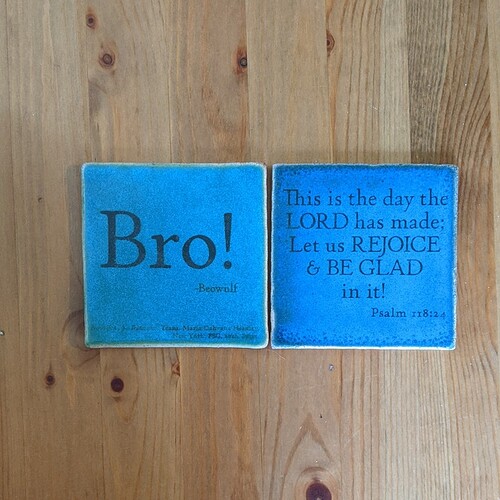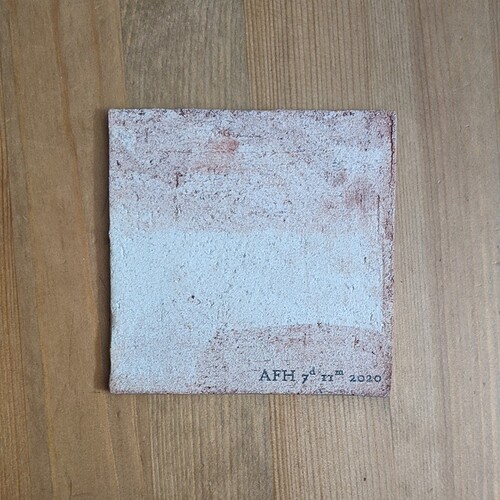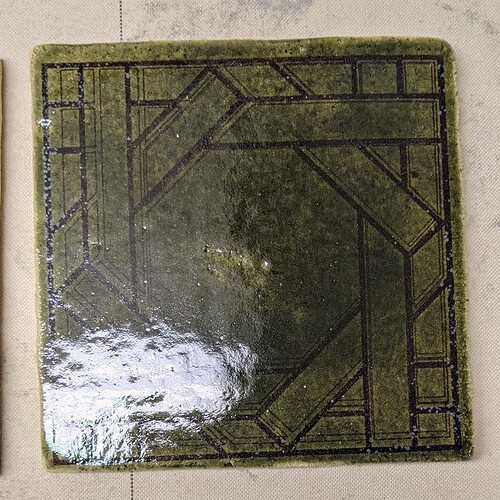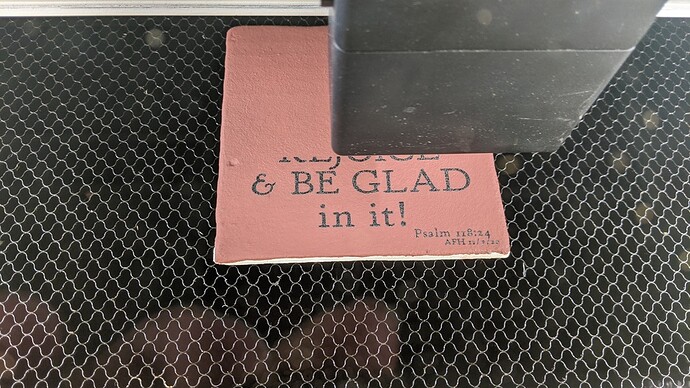Hey folks!
I’ve been experimenting with marking tile with the laser, and have had some excellent results with an iron inlay method:
And here’s the unglazed back of the “day the lord has made” tile, with my initials and the date, so you can see how it looks on unglazed ceramic:
These are handmade tiles, glazed and fired in my kiln, then coated in powdered iron oxide and fused with the glowforge. I got the idea from Rachel Clark’s article Oxide Fusion Printing: A New Method. It’s worth clicking through to her article to get the full details on her process, but the short version is this: once you get the settings right, you can use the laser to inlay a thin layer of iron into the tile. Unlike paint or sharpie, the iron is fused to the ceramic. Much like the bond between glaze and ceramic, it’s stronger than the ceramic itself–you have to chip the tile to remove the iron.
A friend walked me through the chemistry of this a while ago and I believe them, but just for giggles I tried sand sandpaper and a paint scraper on a test tile, and can confirm: the iron doesn’t budge.
The two tiles up top have the iron over the glaze, so I’m not sure if they’re food/dishwasher safe, but for those of us making our own tile, this technique also works under glaze:
This is the product of a lot of ceramics + lasers research and experimentation. I could do a whole separate post about what I’ve learned about laser-assisted ceramics-making, but focusing on this iron inlay technique:
Will it work on commercial tile too?
I haven’t tried it yet, but it should. If anything, commercial tiles might work better, because they’re more uniform in thickness and in the thickness of the glaze.
Is it food/dishwasher/microwave-safe?
As an underglaze, yes–if the glaze you put over it is food-safe, you’re good to go, same as any other iron-based underglaze decal. But this only works if you’re glazing and firing your own tiles.
As an overglaze (on an already-finished tile)–I personally wouldn’t risk it on functional ware (stuff you eat off of), but a glaze nerd may be able to convince me otherwise. It’s perfectly safe for things like trivets and coasters.
Can it be used for tiles that will be installed?
Yes! this is probably its biggest advantage over sharpie/paint methods. Tile is rated for wet and outdoor uses based on how much water the underlying ceramic will absorb, and this process doesn’t change the characteristics of the ceramic.
It’s also safe to use around your fireplace.
Can you do other colors than black?
Rachel Clark demonstrates a range of muted colors in her article using various metal oxides–but it’s worth taking care, as some of these metals are safer to handle than others. You’ll want appropriate PPE, and be sure to double check that the metal you’re trying is laser-safe. Iron oxide is one of the safer ones and fumes are minimal while etching, but these are very fine powders that you don’t want in your lungs. You’ll want to wear an N-95 mask while handling them.
Once they’re dissolved in water, there’s not much risk of inhalation, but fair warning that iron oxide is literally rust and it. stains. everything, including unglazed portions of your tile, as you see on the back of the tile above. (It will also stain your cuticles, if handling it without gloves is a choice you make with your one wild and precious life. Guess how I know).
Can it do raster engraves like a photograph?
I’ve only tried it with solid black designs. I’m not sure how well it’ll handle dot/pattern shading. It definitely cannot handle varying the power for shading–either it’s successfully fused and black, or it’s not successfully fused and doesn’t show up at all.
Where do you get the iron oxide?
Iron oxide is a common ingredient in ceramic glazes and is commonly available from pottery supply shops. What I used for these tiles is Spanish Red Iron Oxide from the Ceramic Shop. (It’s a saturated rust red before fusing, but solid black once fused–the laser essentially creates a “reduction” environment, where the iron oxide heats and cools so quickly that it loses its oxygen and de-rustifies).
The other oxides Clark demonstrates in her article are available from pottery suppliers as well. Some of them are spendier than others.
And now I’ve gotta go to bed, but if anyone else is interested in trying this, I’m happy to chat further!









 .
.